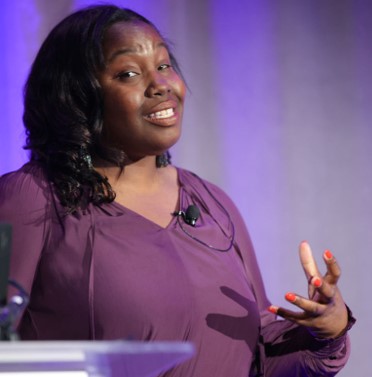7 Trends Defining the Ongoing War for Talent
Executive insights from presenters at the SHRM Talent Conference & Expo 2024 in Las Vegas

The SHRM Talent Conference & Expo 2024 (Talent 2024) highlighted key trends in talent acquisition, emphasizing the necessity for agility in a rapidly changing world. Over three days, experts shared insights and best practices on skills-based hiring, AI adoption, personalized engagement, critical thinking and understanding evolving workforce dynamics for future success.
“When I talk with CEOs about what keeps them up at night, it’s talent,” said SHRM President and Chief Executive Officer Johnny C. Taylor, Jr., SHRM-SCP, in a surprise appearance closing out the event in Las Vegas. “Leaders say that the No. 1 thing we can do is get the right people into our organizations—people with the right technical expertise and who are also culturally aligned.”
Taylor acknowledged that hiring is hard now, and it won’t get easier anytime soon.
“Every organization is saying, ‘We can’t find the right talent,’ ” he said. “That’s an amazing opportunity for talent acquisition. The war for talent is not over. The work is not done."
Here are seven key trends from Talent 2024 for business leaders to understand ahead of the SHRM Annual Conference & Expo 2024 on June 23-26 in Chicago.
1. Talent Challenges Require Creative Approaches
Panelists at Talent 2024’s annual trends presentation spoke about pivotal shifts in talent acquisition strategies and emphasized the need for innovation, particularly in building distinctive employer brands, leveraging technology for efficiency gains and transitioning to skills-based hiring practices to tap into broader talent pools. The panelists discussed the need to embrace technological curiosity, prioritize candidate experience and reframe talent acquisition as a strategic business function.
“Coming out of the pandemic, we found ourselves trying to figure out what to do in order to open back up,” said Justin Fronberg, executive director of talent acquisition at MGM Resorts International. “We had to be creative and shift our mindset when thinking about who we are looking for—teaching people the skills we need, instead of them already having the exact industry work experience.”
Shannon Taylor, director of talent acquisition at JCPenney, highlighted the importance of personalized engagement. “We’ve had to focus on relationships and try to evoke feelings in people to get them to want to join the organization,” he said. “Organizations have different things they provide, and from the talent acquisition perspective, it’s up to us to highlight those things that set us apart.”
The adoption of artificial intelligence in HR, particularly in talent acquisition, is burgeoning, the panelists agreed. Taylor said, “We’re all on the AI journey, trying to figure out, ‘Where does it work? Where does it not work?’ We are experimenting.”
The trend toward skills-based hiring is also gaining momentum. “It tends to happen more when the market tightens, and companies have to be more agile in their approach to hiring,” Fronberg said. “We have found that there are candidates who come our way without the exact industry experience that may still be a fit for our organization.
2. AI Makes Critical Thinking a Must
“Artificial intelligence offers an opportunity and an imperative for enhanced critical thinking skills in the workplace,” said Justin Reinert, SHRM-SCP, a corporate trainer and principal of Performance Accelerated Learning.
Reinert emphasized the importance of human verification of AI-generated results. He warned of the challenge in discerning fact from AI-generated content, citing instances such as fake legal citations in AI-written documents and inaccurate advice from a government chatbot.
He also proposed using automation with a prioritization of human skills. “Identify the things that are uniquely human and make sure you develop those skills in people, and then automate what can be automated,” he said.
Reinert advocated for fostering critical thinking skills, including observation, analysis, inference, communication and problem-solving, through tailored training methods. He emphasized that effective AI implementation necessitates a workforce equipped with robust critical thinking abilities.
3. AI Regulations Require Compliance Coordination
Employers must “coordinate compliance” with various existing laws regulating artificial intelligence, advised Anthony May, an attorney with Brown, Goldstein & Levy in Baltimore.

Relying solely on vendors is risky; instead, HR should “hold their feet to the fire” and question them to ensure alignment with applicable laws, May said. Compliance with one law doesn’t guarantee compliance with another. For example, a New York City law mandates auditing automated employment decision tools for potential race and gender bias. But discrimination prevention via AI also falls under federal laws including Title VII of the Civil Rights Act of 1964, the Americans with Disabilities Act, and the Age Discrimination in Employment Act.
May warned of the “black box dilemma,” where AI decisions are opaque. Recent cases illustrate potential liabilities for both vendors and employers. He advised thorough vendor vetting, including conducting audits for various biases.
4. HR is at a Crossroads
Elliott Masie, a learning and development expert, said HR is at the critical intersection of talent, technology and learning. He urged HR leaders to embrace the evolving landscape, particularly the integration of AI.
“The world of learning is going to change. It’s going to change whether you are wanting it to change or not,” Masie said. He added that HR needs to be ready to advocate for good design in implementing AI tools, saying, “AI is not a standalone solution. It becomes truly powerful when paired with human intelligence.”
Masie encouraged HR leaders to adapt to the learning environment as it evolves. He highlighted AI’s potential, saying, “What if we could truly personalize it based on that person’s background? If we could start the learning based on what they know and what they need to know and if we could personalize it, we could [improve their learning] by 100 percent to 200 percent.”
He concluded by urging HR leaders to navigate the AI journey thoughtfully, considering how to balance innovation with practicality and ensuring alignment with organizational goals and values.
5. Question the Conventional Wisdom on Talent
Industry expert Tim Sackett, SHRM-SCP, picked apart common ideas about recruitment and advocated that business leaders should heed the expertise of their talent acquisition teams who work in the trenches and have an up-close view of what works and what doesn’t when it comes to recruiting and hiring talent.
Sackett questioned mantras such as, “We only hire top talent” and “Quality of hire is the most important metric” as empty statements because recruiters don’t have enough time to truly hire the best person for a role and most organizations do not know how to measure quality of hire.
“If it was so important, there would be a known formula that everyone would know and use,” he said.
Recruiters’ frustrating relationship with hiring managers is not the biggest obstacle to their work, he said— organizational turnover is. “The most productive recruiting teams work for companies with really low turnover,” Sackett explained. He proposed empowering talent acquisition teams to own retention strategies, asserting, “We should own retention.”
Regarding remote work, he stressed the importance of finding environments where employees thrive: “It’s about finding the environment where people are going to be the most successful.” On AI in recruitment, Sackett acknowledged its potential while emphasizing the continued necessity of human oversight, saying, “I’m less afraid of my AI being biased than my sales guy.” He cautioned that amid technological advancements, maintaining human connections remains paramount.
6. Seek to Understand Gen Z
 Chelsea C. Williams, CEO of Reimagine Talent, addressed the enigma of Generation Z, stressing the need for employers to adapt their strategies to recruit and develop this demographic, which is projected to account for 30 percent of the workforce by 2030.
Chelsea C. Williams, CEO of Reimagine Talent, addressed the enigma of Generation Z, stressing the need for employers to adapt their strategies to recruit and develop this demographic, which is projected to account for 30 percent of the workforce by 2030.
With unique values shaped by events such as the pandemic and the student loan crisis, Gen Z (born between 1997 and 2012) seeks professional development, upward mobility, community, purpose and inclusion. Williams advised employers to “acknowledge the changing world of work” and “seek to understand shifts in values, ideals and aspirations.” She emphasized the importance of being specific about skills sought, leveraging data, promoting occupational identity and aligning programs with diverse experiences. Additionally, Williams highlighted the significance of connecting employees to the organization’s mission, upskilling managers, fostering partnerships for workforce development and prioritizing mental health resources.
7. Succession Planning Is Critical for Business Continuity
Prudence Pitter, global head of HR for Amazon Web Services’ automotive, manufacturing, health care and life sciences division, highlighted key strategies for effective succession programs: aligning plans with organizational goals, gaining executive buy-in and identifying successors.
“Succession planning is recognizing the talent we have today and where the organization needs to be in the future,” she said.
Despite the importance of succession planning, many organizations lack formal plans for it due to time and resource constraints. Pitter identified common obstacles, including executive reluctance to consider succession and insufficient preparation of successors. HR plays a critical role in assessing bench strength and ensuring leaders understand the importance of planning.
HR should actively engage leaders, develop successors and adapt plans to organizational needs. “Your plan will be hard to own and embrace if it’s not tailored to your organization’s specific needs,” Pitter warned. Succession planning is dynamic, requiring ongoing evaluation and adjustment to ensure successful leadership transitions.
The discussion around these talent trends is just beginning. Keep the conversation going with over 90 sessions on people and talent at the SHRM Annual Conference & Expo 2024.



